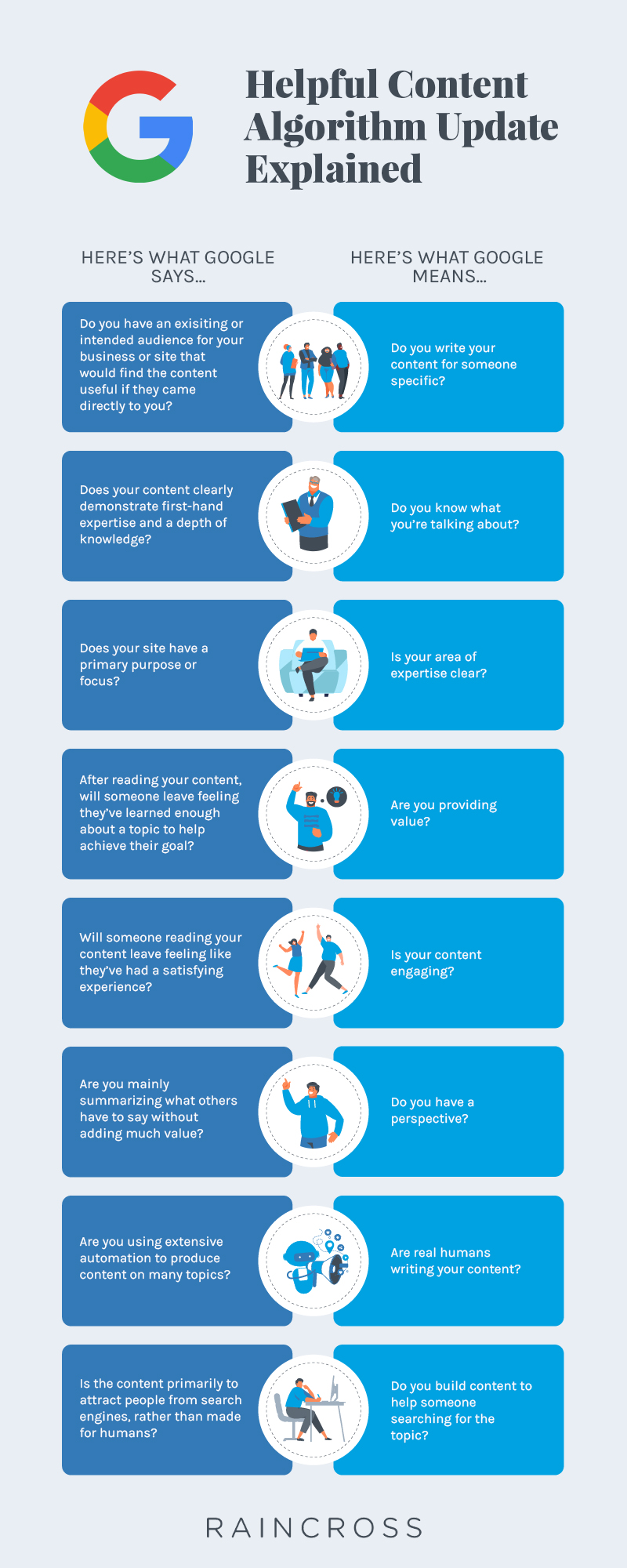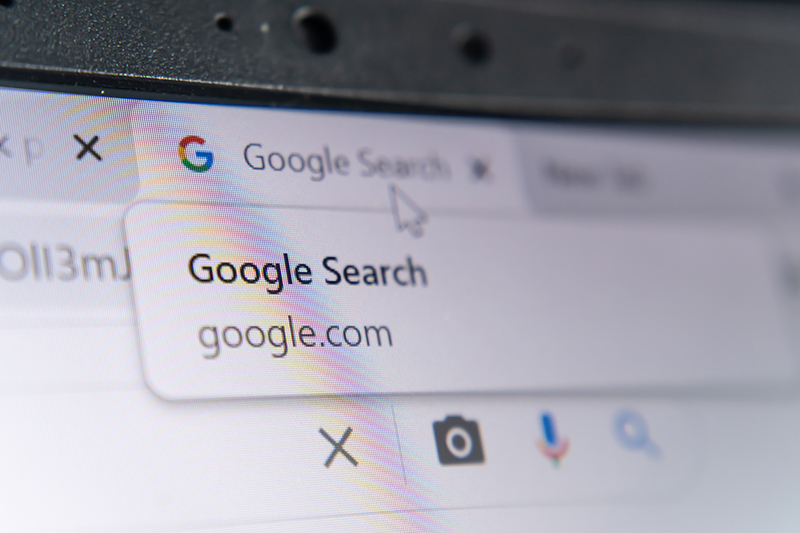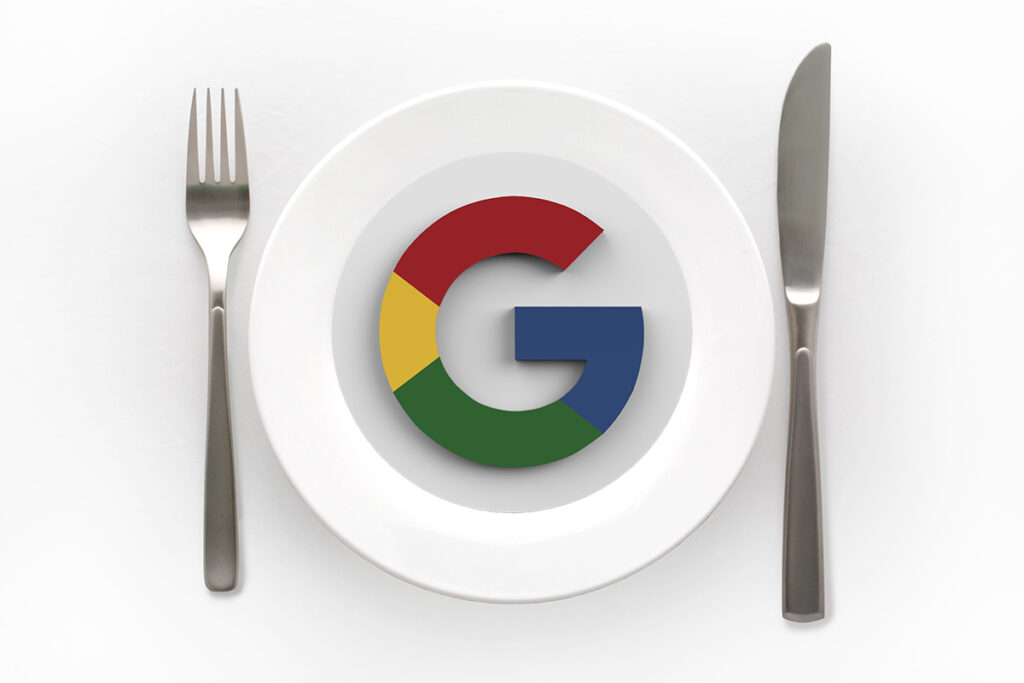On August 18th, 2022, Google announced that they will be making a significant update to their search engine ranking algorithm, called the Helpful Content Update. The search engine giant rarely provides advanced notice about algorithm updates, so we expect this to have a major impact on the SERPs (search engine results pages).
According to Google, the Helpful Content Update introduces a new site-wide ranking signal that will attempt to weed out low-quality content and reward sites that are helpful to users. This update will be rolled out in a series of improvements to search so that people can easily find helpful content made by and for people. According to Google, the so-called Helpful Content Update is “part of a broader effort to ensure people see more original, helpful content written by people for people in search results.”
Before we detail what we know (and what we do not know), we want to remind you of the first rule of algorithm updates: if you create good content already, there is no need to panic or rush to change your entire site before we have more information.
Now, let’s dig into the update, what it means for your site and what actions (if any) you should take right now.
What is the Helpful Content Update?
Google is constantly evolving in an attempt to provide users with more relevant results. To accomplish this, Google has introduced the Helpful Content Update, which is an initiative to make sure users see more helpful, original content created by people, for people, in search results. According to Google, this update to their search engine ranking algorithm “aims to better reward content where visitors feel they’ve had a satisfying experience, while content that doesn’t meet a visitor’s expectations won’t perform as well.”
What Google is looking for are sites that provide information that’s not only timely and relevant but also high quality and helpful. This update is specifically targeted at content that is written for search engines first and people second.
Per Google:
“Any content — not just unhelpful content — on sites determined to have relatively high amounts of unhelpful content overall is less likely to perform well in Search, assuming there is other content elsewhere from the web that’s better to display. For this reason, removing unhelpful content could help the rankings of your other content.”
This is not a Google Core Update, manual action, or spam action, but is a new signal that Google will use to evaluate and rank content for a website. It is also a site-wide algorithm that is weighted. This means that if the machine learning algorithm determines that a relatively high amount of content on a website is unhelpful (or unsatisfying), then it may get flagged with a classifier that impacts the entire site’s visibility in the SERPs (Search Engine Results Pages). Sites with a lot of unhelpful content may notice a stronger effect than sites with a large percentage of helpful (or satisfying) content.
Expected Outcomes of This Algorithm Update
- A large fluctuation in the SERPs across all website industries
- Seeing more search results with unique, authentic information
- Reading content you haven’t seen before
- Fewer low-quality websites ranking in the top SERP positions
- Less AI-generated content that wasn’t written by humans or even for people to read
- Lower influence of backlinks for SEO when the content is considered to be unhelpful or unsatisfying to users by the ranking algorithm
- More content creators taking a people-first approach with content rather than primarily publishing content for search engine traffic
How Will Google’s Helpful Content Update Impact Search Results?
Google’s Helpful Content Update is designed to improve the quality of results for web users. The algorithm will analyze various factors to determine which content is most beneficial for searchers. This includes whether the content is well-written, accurate and informative.
Google has said that this update will significantly impact search results. Therefore, if you produce high-quality, helpful content, you should see a boost in your rankings. On the other hand, if your content is not deemed beneficial, you could actually experience a drop in your rankings. Either way, you will want to monitor your website’s performance after this update goes into effect.
Google’s goal with the new algorithm is to reward websites that are clear and easy to navigate. Websites with low bounce rates rank higher because people find them helpful or informative. Likewise, websites with good page load times (generally less than two seconds) are more likely to rank higher since website visitors do not have to wait to get the information they seek, which directly translates to a better user experience. Google also expects sites with no broken links to rank higher since they offer a smoother user experience.
To make sure your site does well after Google’s Helpful Content Update takes place, remember these five tips:
- Write engaging copy
- Create mobile-friendly pages
- Make sure all links work correctly
- Try to limit bouncing rates
- Include multimedia whenever possible
What Could Happen With a Site-Wide Algorithm Update Like This?
This algorithm will be considering your entire site, not just individual pages. This is a bit different from the recent trend for content-focused updates. That means that some websites who have improved the quality of their content might still be at risk if they have a lot of older, lower-quality content still live on their site. It also means that if the algorithm evaluates your site and finds that it is not meeting these helpful content thresholds, your high-quality content will also suffer.
Expect SERP volatility to be high as the update rolls out. Keep an eye on your analytics but do not immediately panic if you see some changes to your rankings and organic visibility. If you have been consistently applying best practices to your content, including auditing and removing older content, you should not see major problems.
What Does This Mean for Content Creators?
As a content creator, you need to be aware of this update and how it will affect your site’s ranking. With this new update, Google emphasizes helpful and informative content. So if you want to rank higher in search results, you must ensure your content is of the highest quality. That means providing your readers with the value they cannot find elsewhere and ensuring that your content is well-researched and accurate.
And most importantly, it means writing for your audience, not search engines. So take the time to understand who your readers are and what they are looking for. Then give them the information they need in a way that is easy to understand.
Focus On People First Content
The Helpful Content Update aims to better reward content where visitors feel they’ve had a satisfying experience, while content that doesn’t meet a visitor’s expectations won’t perform as well.
How can you ensure you’re creating content that will be successful with our new update? By following Google’s own SEO guide to create content for people, not for search engines. People-first content creators focus first on creating satisfying content, while also utilizing SEO best practices to bring searchers additional value.
Answering yes to the Google’s Recommendations on How to Create People-First Content questions below means you’re probably on the right track with a people-first approach:
- Do you have an existing or intended audience for your business or site that would find the content useful if they came directly to you?
- Does your content clearly demonstrate first-hand expertise and a depth of knowledge (for example, expertise that comes from having actually used a product or service, or visiting a place)?
- Does your site have a primary purpose or focus?
- After reading your content, will someone leave feeling they’ve learned enough about a topic to help achieve their goal?
- Will someone reading your content leave feeling like they’ve had a satisfying experience?
- Are you keeping in mind our guidance for core updates and for product reviews?
Avoid Creating Content for Search Engines First
Our advice about having a people-first approach does not invalidate following SEO best practices, such as those covered in Google’s own SEO guide. SEO is a helpful activity when it’s applied to people-first content. However, content created primarily for search engine traffic is strongly correlated with content that searchers find unsatisfying.
How do you avoid taking a search engine-first approach? Answering yes to some or all of the Google’s Recommendations on Creating Content for Search Engines First questions is a warning sign that you should reevaluate how you’re creating content across your site:
- Is the content primarily to attract people from search engines, rather than made for humans?
- Are you producing lots of content on different topics in hopes that some of it might perform well in search results?
- Are you using extensive automation to produce content on many topics?
- Are you mainly summarizing what others have to say without adding much value?
- Are you writing about things simply because they seem trending and not because you’d write about them otherwise for your existing audience?
- Does your content leave readers feeling like they need to search again to get better information from other sources?
- Are you writing to a particular word count because you’ve heard or read that Google has a preferred word count? (No, we don’t).
- Did you decide to enter some niche topic area without any real expertise, but instead mainly because you thought you’d get search traffic?
- Does your content promise to answer a question that actually has no answer, such as suggesting there’s a release date for a product, movie, or TV show when one isn’t confirmed?
Is E-A-T a ranking factor? Not if you mean there’s some technical thing like with speed that we can measure directly.
We do use a variety of signals as a proxy to tell if content seems to match E-A-T as humans would assess it.
In that regard, yeah, it’s a ranking factor.
— Danny Sullivan (@dannysullivan) October 11, 2019
What Can You Do to Avoid Having Issues?
There are several core areas that you should focus on in order to try to mitigate the ongoing impact stemming from their “Helpful Content” algorithm.
1. Focus On Your Core Topics
If you are an expert in a particular field, then choose your topics precisely and cover them thoroughly. Create specific and unique content that offers your users real added value. This way, you will distinguish yourself as a reliable and relevant source of information that users trust.
2. Answer Your Users’ Questions
Users come to your site looking for answers to a problem or question. Be responsive with your content and provide the answers that will help your users.
3. Focus on Quality & Timeliness
High-quality content is essential for achieving good rankings. However, it is just as important to keep your content up to date. Check your content regularly and set the date of the last update.
4. Strengthen Your Brand
Building your brand in a long-term and sustainable way is a trust-building signal. Strategic content and media sites with a high reputation or established industry authorities are good models for strong brand profiles.
5. Build Trust
Adding seals of approval or quality to your website (such as trade association certificates), integrating social media channels, specific contact persons and using HTTPS encryption creates trust among your users.
Final Thoughts
Google’s latest algorithm update is designed to surface more helpful and informative content for users. This is good news for content creators and website owners committed to creating high-quality content. As time goes on, Google will likely continue to improve on this update. Your best bet is to always create high-quality, engaging content that is targeted toward human beings instead of algorithms and SEO rules.
If you have questions or concerns regarding your content strategy, call us today at (951) 200-4252. We can help.







About The Author: Kevin Watts
Kevin Watts is the founder of Raincross, a premier web design, development and digital marketing agency headquartered in Riverside, CA.
Kevin got his start in online marketing and website design by working for some of the most prominent names in online retail. He's most recognized for helping to start e-commerce retailer Organize.com in 1998, and spent 12 years running the company's e-commerce and online marketing operations. He has been recognized and has received several online retail, marketing and merchandising awards throughout his career.
Kevin grew up in Riverside, CA and graduated from the University of Wyoming. In his spare time, Kevin is an avid fly-fisherman, college football fan, and enjoys spending time with his son Matthew, daughter Kate and wife Lindsey.
More posts by Kevin Watts